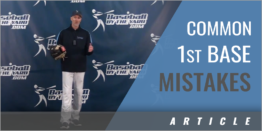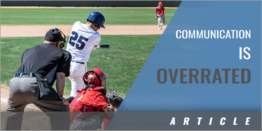|
By: Coach Bob McCreary Provided by: Baseball By The Yard Twilight baseball. A beautiful yet challenging sky for players. Now that summer weather is approaching, more night games will begin to be played around the country. Growing up, there were only a couple fields near me that had lights so playing at night was always quite a treat. In fact, it wasn't until I was in professional baseball that I routinely played games under the lights. Playing under the lights is always fun but it does produce some challenges. A big one is that when the game begins, the sun is starting to set. This twilight sky can be very difficult to manage when balls are hit up into it. For some reason this never seemed to effect me until I played in California. The desert sky was beautiful at twilight but it was also brutal when trying to see fly balls. Regardless of where you live, if you adhere to the following tips, your success in handling fly balls in the tough twilight sky can improve: Practice. If you are going to have to play a game at that hour it makes sense to practice at that hour as well. It doesn't mean all your practices need to be at that time but a few late practices to get used to the sky in combination with the lights can be very helpful. Be aware that it may be a problem. This shouldn't be a problem with your own field since you should already be used to your home field conditions. Traveling to other fields is where the problem may exist. When you arrive, look up several times in the direction you will be seeing the ball from your position. Do this continually until it gets fully dark since light conditions change by the minute. Be aware that it may be a problem and keep your eyes posted on changes in the sky. Point. Just because you see the ball doesn't mean other players on your team do too. When a ball is hit into the sky, any player not involved in the play (especially the pitcher) should be pointing to the ball and yelling "UP!!" as the ball travels upward. If a teammate does not see it, he should be able to follow multiple arms upward and hopefully find the ball. Keep your eyes on the ball. In normal skies, older fielders often will see a ball into the air and temporarily take their eyes off the ball to get to the spot where the ball will land. When they get close, they look up again, find the ball, and catch it. This helps fielders run faster and cover more ground since they are not looking up while they run. This technique takes a lot of practice, though. It's also not a technique to use in a twilight sky. Once you find the ball in the air, do not take your eyes off of it. You may not find it a second time. If you see it, get it. When fly balls are hit there is normally a hierarchy in terms of who should catch the ball. Fly balls hit in the gaps are typically the center fielder's ball. The shortstop and second basemen generally take priority when balls are hit towards them and/or behind the third and first basemen. In the twilight sky, there is no guarantee that the player who is supposed to get the ball will actually see it. In these conditions, all players who see the ball go for it until they are called off. If you see the ball, go for it and catch it. You may be the only guy on the field who knows where the ball is. In some cases, there will be nothing you can do to see the ball. Play the game long enough and you will experience the horror of knowing the ball is hit and having no idea where it is. Multiply that by 10 when you see all your teammates looking at you after you hear the crack of the bat. It's a lonely feeling but one that can be managed better with the help of everyone on your team and a little preparation beforehand. |







